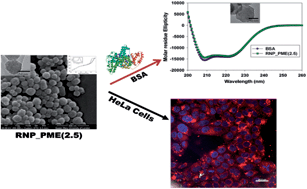Abstract
This paper reports the synthesis of large pore (11 nm) monodisperse raspberry textured phosphonate@silica nanoparticles (70–90 nm) with high capacity for protein immobilization. The raspberry nanoparticles denoted RNP_PME(2.5) with phosphonate loading 2.5 mmol g−1, formed using an organosilanephosphonate (MeO)3SiCH2CH2PO(OMe)2, as silica surface modifier and structure directing agent. Specific reaction conditions including temperature and concentration of phosphonate, base, surfactant and co-solvent were required for RNP_PME(2.5) formation. Rhodamine B labelled RNP_PME(2.5) was readily internalised by HeLa cells with no deficit of cell viability. Aqueous dispersions of RNP_PME(2.5) were stable over several months. In protein immobilization studies using BSA, bovine serum albumin, with RNP_PME(2.5), smaller pore (∼3 nm) phosphonate@silica nanoparticles NP_PME(1.0) and NP_PME(0.2) and mesoporous silica nanoparticles, MSN, the large pore RNP_PME(2.5) gave highest BSA loading 266 mg g−1, formed the most stable aqueous dispersions (BSA@MSN was unstable and precipitated) and gave the best protection against BSA structural distortion at pH 7.4.

- This article is part of the themed collection: In memory of Paul O’Brien

 Please wait while we load your content...
Please wait while we load your content...